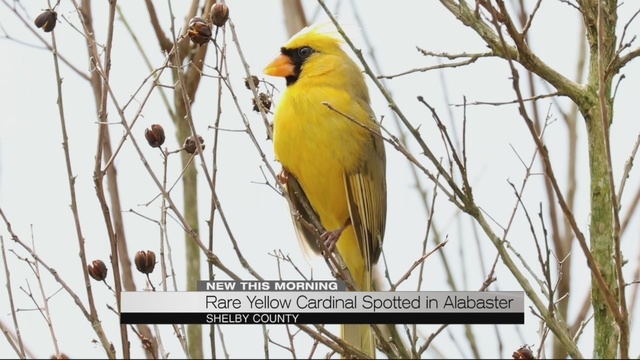Science & Tech
Not the Coal Mine’s Canary: One-in-a-Million Yellow Cardinal Suddenly Appears in Alabama

From a distance, the disarmingly bright-yellow bird could have been mistaken for a goldfinch, warbler, or perhaps an escaped parakeet, at least to the untrained eye; but Shelby County, Alabama, resident Charlie Stephenson hadn’t seen anything like the unusual specimen — which began visiting her backyard feeder in late January — even in her decades of experience birding.
“I thought, ‘well there’s a bird I’ve never seen before,’” she told AL.com.
For good reason: the bird is a yellow cardinal — coloration caused by such an extraordinarily rare mutation, Auburn University biology professor Geoffrey Hill’s own decades of professional experience as an avian curator and researcher focusing on cardinals, he has never seen one in the wild.
“I’ve been birdwatching in the range of cardinals for 40 years and I’ve never seen a yellow bird in the wild,” Hill asserted. “I would estimate that in any given year there are two or three yellow cardinals at backyard feeding stations somewhere in the U.S. or Canada.
“There are probably a million bird feeding stations in that area so very very roughly, yellow cardinals are a one in a million mutation.”
Stephenson, who understandably refused to give her location other than the town of Alabaster, shot a brief video of the rare bird and posted it to social media, instantly captivating the attention of friend and professional photographer, Jeremy Black — who then asked if he might try to catch a glimpse of the yellow cardinal, firsthand.
“As soon as I saw it on her social media, I was kind of curious and I wanted to go explore and see if I could find it,” Black remarked to AL.com; and, perched quietly in his friend’s backyard, on February 19, “I finally saw it after about five hours.”
He explained, “I started out sitting in her backyard hoping that maybe I would see it. A lot of cardinals came by and none of them were yellow, so I decided to be a little bit more evasive and hide on her screened-in porch. About two or three hours after I moved to the porch, it finally showed up.”
Hill, who has written books on bird coloration and also studied the specific mutation which results in a yellow cardinal, notes songbirds obtain their color through a diet of carotenoid-containing plants:
“Songbirds like cardinals almost never consume red pigments; rather they consume abundant yellow pigments. So, to be red, cardinals have to biochemically convert yellow pigments to red.”
Researchers including Hill identified CYP2J19 as the enzyme necessary for that process in most cardinals — although he opined from afar, on sabbatical in Australia, the possibility of collecting a yellow cardinal feather for DNA testing to further discern the precise mutation.
In the meantime, Black remains dedicated to capturing the unique and rare scene of the sunny-yellow bird next to one of its commoner red counterparts — a rarer than once-in-a-lifetime shot.
“I’m trying to get a unique photograph and that is the yellow cardinal next to a traditional North American red cardinal. My current goal is to try and visit her backyard or neighborhood as frequently as possible and see if I can get that shot with both birds together.”
Stephenson emphasized she had no idea how rare a yellow cardinal might be, telling AL.com, “I’m used to being a birder and you see some leukocytic ones, you see some albino ones. But I thought this was something else and then I learned how rare it is.”
“Of all the places, he’s in Alabaster, Alabama,” the birding enthusiast and homeowner told the Shelby County Reporter. “I wonder how many people have actually seen the bird and not thought anything of it.”
Image: Photographer Jeremy Black/Wiat.com.
Typos, corrections and/or news tips? Email us at Contact@TheMindUnleashed.com
